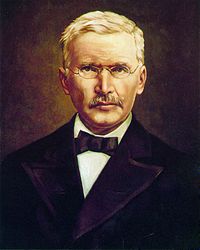Friedrich Wilhelm Raiffeisen
Friedrich Wilhelm Raiffeisen | |
|---|---|
 | |
| Born | 30 March 1818 |
| Died | 11 March 1888(aged 69) Neuwied,Kingdom of Prussia,German Empire |
| Known for | Pioneer of cooperative banking and credit unions |
| Spouse(s) | Emilie Storck (1843) Maria Panseroth (1867) |
| Children | Amalie Raiffeisen(1846-1897) six others |
| Parent(s) | Gottfried Friedrich Raiffeisen Amalie Christiane S. M. Lantzendörffer |
Friedrich Wilhelm Raiffeisen(30 March 1818 – 11 March 1888) was a Germanmayorandcooperativepioneer. Severalcredit unionsystems andcooperative bankshave been named after Raiffeisen, who pioneered rural credit unions.
Life
[edit]Friedrich Wilhelm Raiffeisen was born on 30 March 1818 atHamm/Sieg,Westerwaldregion. He was the seventh of nine children. His father Gottfried Friedrich Raiffeisen was a farmer and also served as the mayor of Hamm. His family’s origins trace back to the 16th century in theSwabian-Franconianregion. The family of his mother, Amalie Christiane Susanna Maria, born Lantzendörffer, came from theSiegerlandregion.[1]Leaving school at the age of 14 he received three years of education from a localpastorbefore entering the military at the age of 17. His career in the military led him toCologne,Koblenz,andSayn.After an eye disease forced him to resign from military service in 1843 he entered public service. He served as themayorof several towns: from 1845 he was the mayor ofWeyerbusch/Westerwald;from 1848 the mayor ofFlammersfeld/Westerwald; and the mayor of Heddesdorf from 1852 until late 1865, when, at the age of 47, his worsening health cut his career short. He had contractedtyphusin 1863 during an epidemic which took his wife's life.[2]As his small pension was not sufficient to meet the needs of Raiffeisen’s family he initially started a small cigar factory and later a wine business.
In 1867, he married the widow Maria Panseroth. She outlived him by 12 years and their marriage remained childless. He died on 11 March 1888 in Neuwied-Heddesdorf, shortly before his 70th birthday.[1]
Work
[edit]
Raiffeisen conceived of the idea ofcooperativeself-help during his tenure as the young mayor of Flammersfeld. He was inspired by observing the suffering of the farmers who were often in the grip ofloan sharks.He founded the first cooperative lending bank, in effect the first ruralcredit unionin 1864.
Motivated by the misery of the poor during the winter famine of 1846/47 he founded the “Verein für Selbstbeschaffung von Brod und Früchten” (Association for Self-procurement of Bread and Fruits). He bought flour with the help of private donations. The bread was baked in a community-built bakery and distributed on credit to the poorest amongst the population. A bread society as well as an aid society were founded in 1849 in Flammersfeld, and a benevolent society was created in 1854 in Heddesdorf. The societies were pre-cooperative organizations based on the principle of benevolent assistance.
To ensure liquidity equalization between the small credit banks, in 1872 Raiffeisen created the first rural central bank atNeuwied,the “Rheinische Landwirtschaftliche Genossenschaftsbank” (Rhenish Agricultural Cooperative Bank). In 1881, Raiffeisen created a printing house in Neuwied that still exists today, carries his name and was merged in 1975 with the German cooperative publishing house “Deutscher Genossenschafts-Verlag”.[1]
Philosophy
[edit]Raiffeisen stated that there is a connection between poverty and dependency. To fight poverty one should fight dependency first. Based on this idea he came up with the three 'S' formula:self-help,self-governance,and self-responsibility (in the originalGerman:Selbsthilfe,Selbstverwaltung,andSelbstverantwortung). When put into practice, the necessary independence fromcharity,politics,and loan sharks could be established.[4]
Organizations named for Raiffeisen
[edit]Severalcredit unionsare named after Raiffeisen:
- Raiffeisen Zentralbank,RZB, a cooperative bank based in Austria, and operating in Eastern Europe.
- The Kosovo subsidiary of RZB sponsors the soccerRaiffeisen Superleague of Kosovo.
- Bundesverband der Deutschen Volksbanken und Raiffeisenbanken,a federation of Raiffeisen cooperatives in Germany.
- Raiffeisen (Switzerland),the federation of Raiffeisen cooperative banks in Switzerland.
- Federazione Raiffeisen (Alto Adige - Sudtirol, Italia),the federation of Raiffeisen cooperative banks in the autonome province of Bozen, Sudtirol.
- Raiffeisen Bank (Romania),a branch of the Raiffeisen Zentralbank.
- Rabobank,officially Coöperatieve Centrale Raiffeisen-Boerenleenbank B.A., cooperative banking system in the Netherlands.
- Banque Raiffeisen,Luxembourg.
- KBC Bank,the C stands for Cera (Centrale Raiffeisenkas, meaning Central Raiffeisen Bank).
See also
[edit]References
[edit]- ^abc"Internationale Raiffeisen-Union".Accessed: 18-04-2011.
- ^Friedrich Wilhelm Raiffeisen 1818-1888,Deutscher Raiffeisenverband (in German), undatedArchived2007-10-09 at theWayback Machine.Accessed: 06-15-2008.
- ^Raiffeisen, Friedrich Wilhelm (author); Engelmann, Konrad (translator) (1970) [1866].The credit unions (Die Darlehnskassen-Vereine).Neuwied on the Rhine, Germany: The Raiffeisen Printing & Publishing Company.OCLC223123405.
{{cite book}}:|first1=has generic name (help) - ^Raiffeisen levensroman van een groot pionier, Rabobank Nederland Coöperatie & Bestuur AB, 2005.
External links
[edit]- Deutscher Raiffeisenverband e.V.
- International Raiffeisen Union,dedicated to promoting the life, work and ideals of Herr Raiffeisen and his cooperative movement's ideals.
- .Encyclopedia Americana.1920.
- Newspaper clippings about Friedrich Wilhelm Raiffeisenin the20th Century Press Archivesof theZBW
